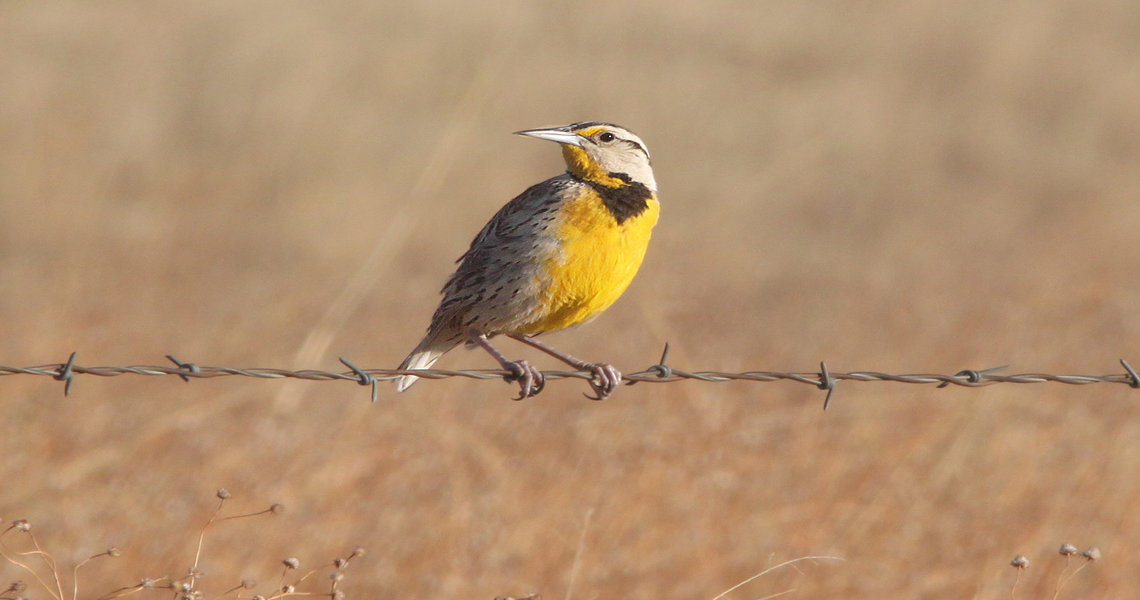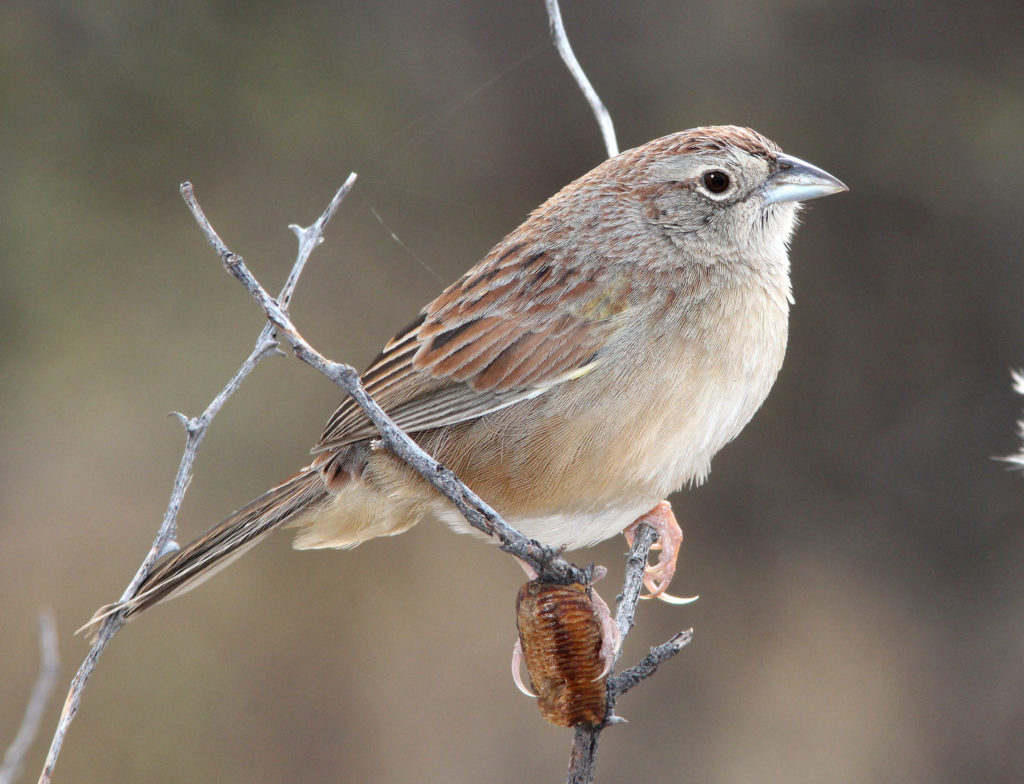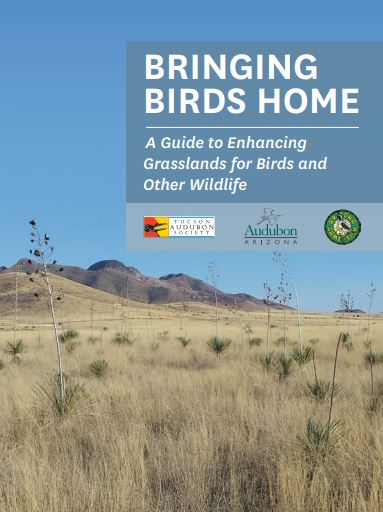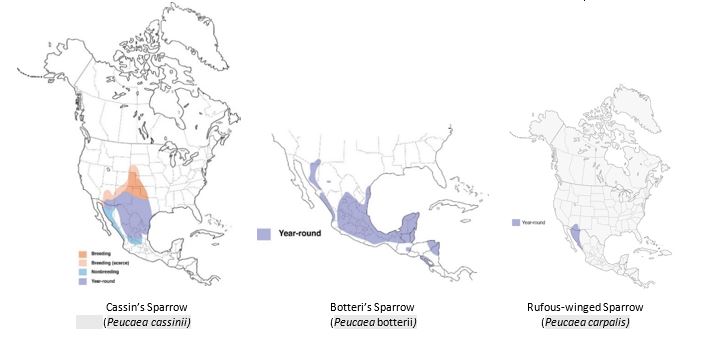
The Lilian’s Eastern Meadowlark is a lovely sight in the grasslands (photo courtesy of Alan Schmierer).
By Tice Supplee, Director of Bird Conservation for Audubon Arizona
When I think of birds in the grasslands, a bird identification booklet I encountered in the 1970s titled “Little Brown Bird What Are You?” always comes to my mind. Appreciating the little brown jobs diving into the tall grass requires a certain amount of commitment. My own “awakening” to the amazing birds of our grasslands happened when I was at the Appleton-Whittell Research Ranch of the National Audubon Society. It was in late July after the monsoon rains had begun, and now these hard to identify grassland birds were singing their hearts out and perching boldly in plain view!
I now look forward to hearing the singsong of Cassin’s Sparrows and the bouncy ball notes of Botteri’s Sparrows each summer. The most interesting aspect of the grassland birds in southeastern Arizona is the number of species with a core range in Mexico that extends into the southwestern grasslands. Three of the species are in the same genus, Peucaea, and each occupies a unique niche within the grassland ecosystem.

The northernmost range of the Botteri’s Sparrow extends just into the southeastern grasslands in Arizona and New Mexico (photo courtesy of Alan Schmierer).
Botteri’s Sparrows are most abundant in the sacaton grasslands found in drainages and swales. They seem to be taking advantage of the non-native Lehman’s and Boers lovegrass, finding suitable habitats in the upland grasslands. Before extensive surveys and increased interest by birders, the Botteri’s Sparrow was once thought to be rare. Today, the bird is of low conservation concern. Cassin’s Sparrows are more widely distributed, and in good rain years, singing males appear at the northern and western limits of the range. The males perch on a twig, fly up into the air, and float back to the ground while singing, a behavior sometimes described as “skylarking.” The Rufous-winged Sparrow is adapted to the grasslands within the Sonoran Desert, and prefers a cactus and grassland mix. Rufous-winged Sparrows are on the watch list because of a restricted range and sparse distribution.
The Grasshopper Sparrow, in the genus Ammodramus, is a common bird in steep decline that prefers pure grasslands. The best tip off to their presence is their buzzy insect-like song. In flight, this small bird has a stubby tail and flies low to the ground, quickly diving into the grass. The breeding population in Arizona is a distinct subspecies (ammolegus), and like the other southeastern Arizona grassland birds, they begin breeding with the onset of the summer monsoon rains. Birds in the Plains of Sonoran grasslands are resident. USGS Research Ecologist Dr. Janet Ruth studied this population extensively, documenting the construction of domed nests found on the ground primarily in native bunch grasses, with the nest opening oriented to the north (click here and here to access some recent publications).
Two other subspecies of particular interest are the Lilian’s Eastern Meadowlark and the Azure Eastern Bluebird. Lilian’s Meadowlark is limited in distribution to the grasslands of northern Mexico, Arizona, New Mexico, and west Texas. The Azure race of Eastern Bluebird is part of a resident population found throughout the Madrean highlands of Mexico. Also found in Arizona’s grasslands, Scaled Quail, locally called “cottontops,” are the true grassland quail. Their distribution has contracted with the loss of desert grasslands further to the west, but numbers remain stable in the healthy grasslands of southeastern Arizona and the Chihuahuan Desert.
Within the geography of the Sonoran Joint Venture in Arizona, a number of Important Bird Areas support valuable grassland habitats. These include San Rafael Grasslands, Las Cienegas National Conservation Area, and the Appleton-Whittell Research Ranch of the National Audubon Society. The Bureau of Land Management and the Coronado National Forest are important conservation partners along with private ranch owners.

Audubon Arizona worked with many partners to develop this pocket best practices reference booklet for land managers and landowners (Image courtesy of Audubon Arizona).
Birds associated with North American grasslands are in decline. The primary threats are loss of grasslands to agriculture and increased development as the west populates. The National Audubon Society recognizes that traditional ranching can conserve native grasslands and protect birds, open spaces, and soil health while supporting rural communities. Demonstrating this recognition, a new Audubon program, Conservation Ranching, has launched in 11 states. The basis of the program is to create partnerships with conservation-minded ranchers who are also willing to raise grass-fed beef. Audubon hopes to launch the program soon in Arizona.
On a local scale, Audubon recognized the need to provide managers and owners of grasslands in the state an easy reference to beneficial management practices for grassland birds. With funding assistance provided by the Sonoran Joint Venture, Arizona Game and Fish Department, National Fish and Wildlife Foundation, and Arizona Antelope Foundation, we produced the pocket booklet Bringing Birds Home: A Guide to Enhancing Grasslands for Birds and Other Wildlife. Download your hi-resolution copy HERE and please share with others.
Arizona grasslands and the birds that depend on them are diverse and beautiful. I encourage you to spend a rainy summer day experiencing the sights and sounds they offer.


 English
English  Español
Español 
